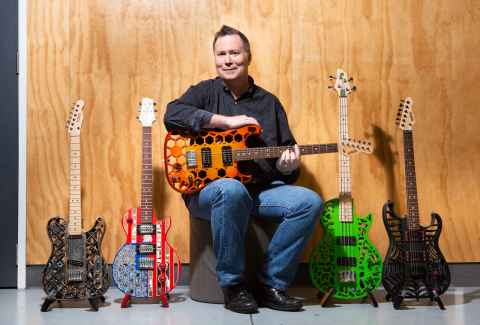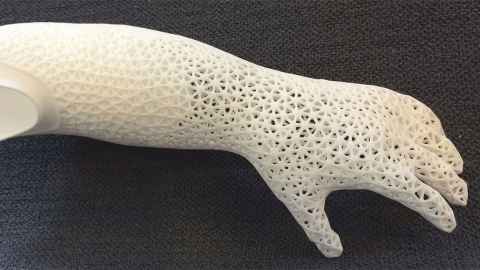Olaf Diegel: How 3D printing lightens the load
6 May 2019
Professor Olaf Diegel is a specialist in 3D printing or additive manufacturing (AM).

Professor Olaf Diegel's 3D-printed guitars are a hobby for the world-renowned specialist in additive manufacturing (AM) or 3D printing. He makes them as a tangible example to demonstrate what additive manufacturing is all about.
“I purposefully designed them to show off 3D printing. The Americana has New York City inside the guitar, Brooklyn Bridge, Yankee Stadium …”
The black guitar has spiders, the orange one is a hive with bees inside. An oxidised one has moving cogs and the green one is his treasured bass. They’re all printed in white and painted by an artist friend and he’s made 72 of them so far. He also has a 3D printed drum kit, keyboard (white with ladybugs) and a skull-shaped microphone.
But Olaf has many strings to his bow and less time to be making guitars since arriving at Auckland this year as the third appointee under the Government’s Entrepreneurial Universities programme. He’s setting up the University’s Creative Design and Additive Manufacturing Lab, the main objective of which is to teach industry how to use AM and how to design for AM. There’ll be an open day later in the year to show the massive potential already being demonstrated in Europe and the US, leaders in the field.
The term additive manufacturing reflects the process of adding layers of material to build a complex three-dimensional part. Objects are designed in 3D – a skill engineering students are expected to develop during their studies, and which can even be learned through free software.
Olaf’s office, aside from many guitars, has boxes of prosthetics, model bits of spine and engines – all 3D printed in plastic, aluminium, stainless steel or titanium. “Many are sample parts for companies to teach them about the technology. Parts are 60 percent lighter … weight-saving on a satellite, an aeroplane or a car adds big value.”
He shows us a custom-made prosthetic arm for a pre-schooler that fits her perfectly but can be reprinted overnight as she grows. For a rough-and-tumble youngster it’s a good alternative to using a bionic hand at the cost of $US 20,000.
“In the future there will be an app where she can add dragonflies or unicorns or Hello Kitties or whatever to really make it her own.”
They’ve done bladders, trachea and heart valves but not more complex organs yet … it’s not far away. A kid in South Africa lost his ear so they printed one.
Already Olaf’s colleague and students, who spun out a company called Anatomic Studios, have printed a leg prosthetic for man that has tattoos that match his other leg.
Soon, pets may also benefit. “I have two students working on pet prosthetics,” says Olaf. “What happens now is, if your dog gets his paw crushed, vets amputate the whole limb. The idea is to make a paw prosthetic so you don’t need to amputate. The problem may be in getting vets to accept there’s a new way of doing things… ”
Part of Olaf’s role is to work with companies to explain the benefits of 3D technology and he’s also about to publish a book on design for additive manufacturing. “Europeans and the Americans are leading the way in terms of company adoption. Aeroplane companies are adopting this big time. If you can lose a kilo on an aeroplane that’s thousands of dollars in fuel savings a year.”
He says New Zealand is punching above its weight in AM, with world-class companies such as Ram3D in Tauranga and Zenith Technica in Auckland, producing parts for companies around the world. But it’s in the industrial adoption of AM that we’re a bit behind.
“We are starting to see companies, such as Rocket Lab, who are already using it, and Air New Zealand realising its potential but we need to get our many SMEs to take advantage of what it has to offer too.
“The yacht industry too, and I’m not just talking America’s Cup, but if you’re buying a million-dollar yacht, you probably want every widget on it to be custom-made, which you can do with 3D printing.
"My goal is also to form a better relationship between the pure academics and industry people to get both working together in much better ways and to help students with start-up ideas or spin-off companies. These relationships modernise a university – we can no longer just stand at the front of the classroom. We have to advance New Zealand in some way. Working with industry is a good way to do that.”
The potential of AM with human organs using stem cells is vast. “It works layer by layer,” says Olaf. “You take a model of a bladder, for example, and slice it into thin slices. Then you print it with layers of stem cells which are then suspended in hydrogel to keep them in the shape. The stem cells know that they’re supposed to be a bladder so they grow into the bladder. As they grow, the hydrogel gets displaced by the real cells.
“I’m not a biologist so I don’t fully understand the biology of how a stem cell knows it’s supposed to be a heart or bladder or kidney. But apparently they do when in the right configuration in the right environment. That’s part of what I enjoy about working in this area – the interdisciplinary collaboration with experts from almost all fields who understand all the stuff I don’t.
“They’ve done bladders, trachea and heart valves but not more complex organs yet … it’s not far away. A kid in South Africa lost his ear so they printed one. It wasn’t from stem cells but it feels real and looks real.”

Back to the guitars, what about the acoustics?
“One of the difficulties with music is that it’s subjective. People say a wooden guitar sounds better than any other material guitar. It’s largely psychological. With electric guitars it makes little difference, although I’ve done one semi-acoustic, rock ‘n’ roll style guitar that has some resonance, until it’s plugged in.
"Probably the single biggest factor in guitar sound quality is the player. You can give a good guitarist a $10 guitar made from a toilet seat and they will make it sound like heaven.”
Olaf Diegel will speak at Raising the Bar on 27 August 2019. His topic is "A house, your shoes, your dinner! 3D printing the future".
This story first appeared in the May 2019 issue of UniNews.